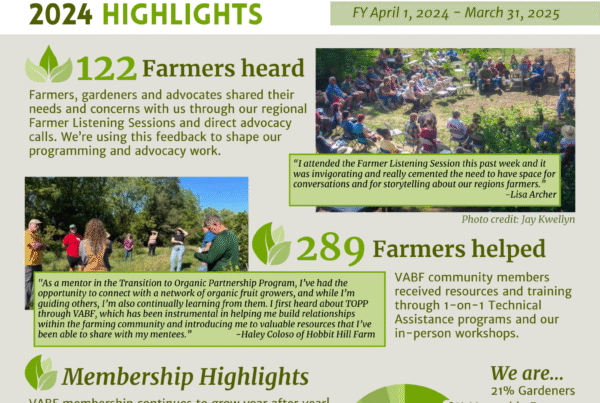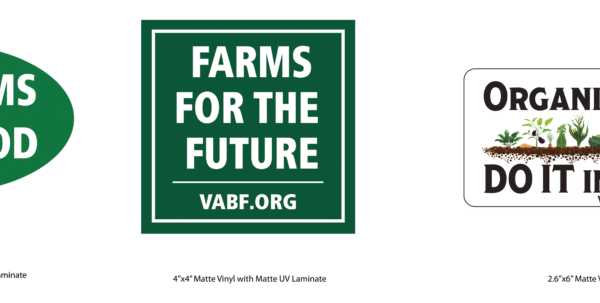By Mark Schonbeck
Many organic farm suppliers are now carrying several newer products – various inoculants, humates, biochar – designed and claimed to enhance soil quality, soil life, functional soil biodiversity, and thereby crop yields and quality. (I learned about it from Seven Springs Farm.) Based on various aspects of cutting edge research on soil health, soil biology, soil-plant-microbe interactions, and soil carbon sequestration (aka building soil organic matter and thereby absorbing some of the excess CO2 in today’s atmosphere), several vendors have developed various products claimed to give substantial benefits to one or more of the above, and of course to crop yield and quality.
At this point, I have no informed opinion as to whether any one of these products might be what your soil needs, or how consistently any of them would give perceptible benefits over a wide range of soils, climates, and farming system. However, there is enough scientific evidence to suggest that each of these products is likely to be helpful in certain circumstances, depending on soil type, climate, current soil condition, crop rotation, etc. There is also reason to believe that two or more products might work best in combination with each other and with other important practices such as cover cropping and inputs of compost and other on-farm organic residues. And the nice things about these products is that the worst that can happen is that they don’t make any difference – they are all quite benign and very unlikely to upset soil balance in any way.
THE PRODUCTS
Actosol Organic Biostimulant – a formulation of humic and fulvic acids (components of humus) claimed to enhance crop nutrition, root growth, and soil biology.
BioChar (CharGrow) – this is a specially manufactured charcoal that interacts with soil microorganisms and plant roots in a way that is supposed to enhance soil biology, nutrient release from organic residues, and plant nutrition and growth. Biochar products are an outcome of research on some atypically fertile and resilient soils in the Brazilian Amazon River Basin. Most soils of tropical forests are extremely fragile, and if they are cleared and put into vegetable or row crop production, the soil burns up all its organic matter, becomes bereft of soil life, and in some cases can turn to stone within a few years. However, in many small tracts within the Amazon, where indigenous peoples apparently added charcoal and organic residues (food scraps, dung, etc) each year for many generations, the soil has become very dark (“terra preta”) and rich in stable organic matter. When good sustainable practices are used, these soils can be cleared and cultivated for crop production for centuries without a serious loss in soil quality. Whether and how a similar approach to amending the soil (biochar + cover crops + other organic inputs) can give similar benefits in other regions (such as the humid temperate climates of the eastern US) is a subject of research by advocates, skeptics, and impartial scientists alike. Biochar is a new product in the Seven Springs catalog.
Black Castings – a high quality worm castings product that I have found very helpful in greenhouse potting mixes at 10% by volume of the final mix. I have also used it in the field but have not seen as clear a benefit – the rates needed for field application may be too high to be economical. However, the enhanced seedling vigor resulting from greenhouse use has carried over into 10% yield increases in research trials even when no additional castings were used in the field.
Endomycorrhizal Inoculant (BEI) from BioOrganics – a blend of eight species of endo-mycorrhizal fungi (also known as Vesicular-Arbuscular Mycorrhizae or VAM). Most of our vegetable, fruit, and cut-flower crops benefit from root-synbiosis with one or more of these endo-mycorrhizal fungi – exceptions include the brassica plant family (kale, broccoli, cabbage, cauliflower, arugula, mustards, Asian greeens, radishes, turnips), and the chenopod plant family (spinach, beet, chard). Onion family, strawberry, tomato family, legumes, and corn form especially strong VMA symbioses that are highly beneficial to crop nutrition, water uptake, and resistance to root zone diseases. These beneficial fungi are present in many but not all soils, and tend to go dormant when soil phosphorus (P) levels are above optimum (“very high” or “excessive” on a soil test report). Mycorrhizal-host crops are most likely to benefit from this product on soils with low to moderate P levels and low pre-existing levels of VAM fungi (low OM, heavily tilled soils are likely lower in VAM).
Inocucor Garden Solution Concentrate – this is a blend of bacteria and yeast that is believed to interact with the indigenous soil food web to enhance its functioning, both in the breakdown of fresh organic residues (cover crops, green manures, animal manure + bedding, crop residues, kitchen scraps), and in crop nutrition and health. Field trials are reported to have realized 10% to 30% yield increases with Inocucor treatment (soil drench or foliar spray). Inocucor is a new product in the Seven Springs cataolog.
Humic DG (the DG stands for Dry Granule) – this is another fulvic-humic acid product based on leonardite, which is a highly stabilized material, a “carbon matrix” that enhances micronutrient availability and uptake, and builds soil structure. Humic DG is a new product in the Seven Springs cataolog
Pfeiffer BD Field Spray – this product has been around for at least 60 years – it was developed by Dr. Ehrenfried Pfeiffer, who, by the way, hired my father to manage his 35-head dairy herd on 185 acres in Chester, NY (about 60 mi northwest of the Big Apple), from about 3 years before my birth until a little after my sixth birthday. Dr. Pfeiffer had a lab in nearby Spring Valley where he did all his arcane biodynamic research, developing and refining the preps and the compost starter and field spray. While biodynamic theory claims all kinds of subtle spiritual and energetic benefits from the field spray, the science suggests that at the least it provides a diversity of beneficial soil food web organisms.
VermaPlex – this is essentially a tea made from Black Castings, spiked with a few added species of endo-mycorrhizal and ecto-mycorrhizal fungi (the latter are most important for forest trees and other woody perennials, perhaps fruit trees). I have used this one a bit, but have not done any side by side comparisions to test its efficacy.
MY VIEWPOINT ON THESE PRODUCTS
Basically, to create a healthy, diverse community of soil life – many species of bacteria, actinomycetes, fungi, protozoa, nematodes, micro-arthropods (tiny insects and mites), and earthworms, you need three things: the beneficial organisms themselves, food for them, and “housing” (habitat, including micropore spaces with adequate moisture and oxygen) for them. A given soil can be below par because the organisms are absent or depopulated (usually one or a few components of the food web are deficient, rarely is a soil completely “dead” or devoid of life), or because they are underfed or starving (and thus dormant if not dying out), or because they lack habitat (as in a very sandy soil with little humus, or in a badly compacted loamy or clayey soil with literally no space and not enough air – think cramped, stinky alleys in a crowded city…). Different soils may be missing different components or aspects of the requirements for a healthy living soil – thus different soils might respond very differently to the above products.
Most of the “food” comes from plants – keeping the soil covered with living vegetation and/or organic residues as much of the year as possible, and maximizing abundance and depth of living plant roots (which exude 10-20% of the plant’s photosynthetic product into the soil to support the soil food web). Returning other farm residues – manure, crop residues, etc, to the soil also provides microbial food. However, it is possible that certain specific microbial nutrients are lacking in an otherwise well fed soil – this is where materials like Actosol or possibly Humic DG might come in – as a supplement to the “food.”
Other products on the above list will supplement / replace parts of the soil food web that are lacking or below par – examples include VermaPlex, Inococor, Pfeiffer BD Field Spray, and Black Castings. The Endomycorrhizal Inoculant addresses a very specific need – if your soil happens to be already rich in VAM, you will not see a response to this product. A high quality compost is also a good general inoculant; it may or may not address the specific needs of a certain soil as effectively as one of the above products.
The Biochar and Humic DG and possibly the Actosol help to provide “housing” or habitat for good bugs by adding stable organic carbon in porous forms that create vital niches for soil microbes.
Note that adding the organisms may be ineffective if the “food” and “housing” are missing; conversely, adding “food” and/or “housing” might not improve soil health or crop yield very much if the soil biology is missing or incomplete.
Thus, these products and tools might be most effective when used in combination – both with each other and with – most importantly – good organic management practices such as a tight rotation that includes high biomass cover crops and minimizes bare soil periods and avoids excessive tillage.
For example, adding biochar might not by itself improve yields in an intensive vegetable rotation – but add a couple of good cover crops to the rotation and spray Inocucor and/or other inoculants just before mowing or incorporating the cover crop, – then you have billions of well-fed soil organisms to move into the “housing” of the biochar – and the biochar itself may help stabilize organic matter from the cover crop, manure, and/or compost added, thus providing yet more habitat.
At present, this is all theory on my part, but it seems quite possible that such synergism may occur, and may explain why no single product will ever be a silver bullet for all of our fields regardless of research-based claims by the most honest and ethical of product manufacturers. When adding a single product does yield a substantial or dramatic result, it has clearly provided a missing link in an otherwise complete system. I think that there is real potential in these new products and methods – when used in combinations that optimize the whole system. In our gardens, I am currently trying combinations of Inocucor and Biochar versus each alone or neither to see if the two materials, with different modes of action, do indeed act synergistically to realize the full potential of our fairly fertile soils.
About Mark Schonbeck:
 Mark Schonbeck has worked for 28 years as a researcher, consultant and educator in sustainable and organic agriculture. He has led or participated in several on-farm research projects (mulching systems, cover crops, organic minimum tillage, and organic nutrient management) supported by funding from SARE, USDA Organic Transitions (ORG), and Organic Farming Research Foundation (OFRF). During 2010-14, he participated in the project team for a National Conservation Innovation Grant project, Integrating Sustainable and Organic Agriculture into NRCS Programs, funded through the USDA Natural Resources Conservation Service (NRCS) with National Center for Appropriate Technology (NCAT) as the lead organization. He also served on an advisory committee for an OREI funded project on Brown Marmorated Stink Bug (lead organization Rutgers University).
Mark Schonbeck has worked for 28 years as a researcher, consultant and educator in sustainable and organic agriculture. He has led or participated in several on-farm research projects (mulching systems, cover crops, organic minimum tillage, and organic nutrient management) supported by funding from SARE, USDA Organic Transitions (ORG), and Organic Farming Research Foundation (OFRF). During 2010-14, he participated in the project team for a National Conservation Innovation Grant project, Integrating Sustainable and Organic Agriculture into NRCS Programs, funded through the USDA Natural Resources Conservation Service (NRCS) with National Center for Appropriate Technology (NCAT) as the lead organization. He also served on an advisory committee for an OREI funded project on Brown Marmorated Stink Bug (lead organization Rutgers University).
Most recently (Nov 2014-May 2015), he has worked on contract with OFRF on a USDA Organic Research and Extension Initiative (OREI) funded Analytical Project, entitled Taking Stock: Analyzing, Assessing, and Reporting Organic Research Investments 2002-2014.” This project is reviewing USDA funded OREI and ORG projects throughout the history of these two programs to determine how well they engage farmers as partners and address organic research priorities.
Mark has edited the quarterly newsletter for Virginia Association for Biological Farming (VABF) since 1997 and serves as VABF’s primary policy liaison with the National Sustainable Agriculture Coalition. He has also written numerous information sheets for producers on cover crops and soil quality management, and about 25 articles on weeds and organic integrated weed management for eOrganic, most of which have been published on eXtension.
VABF has conducted three Specialty Crop Block Grant project: production and disease management in organic winter squash (2009-10) production and pest management in organic summer squash (2011-12) and organic grafted tomato production (2013-14). Each of these projects was conducted at six participating farms, for which Mark provided organic fertility recommendations based on soil test reports.
Mark has lived in a cooperative land-sharing community in Floyd County, Virginia since 1991. During that time, he has worked in the community’s food gardens (0.25 – 0.5 acre). He was the primary manager of the community gardens during 1991-96, and continued to provide both labor and consulting to other garden managers since. Through this experience, he gained first-hand knowledge of the pests, diseases, and other production challenges that organic vegetable farmers in the Appalachian region of Virginia face day to day.






